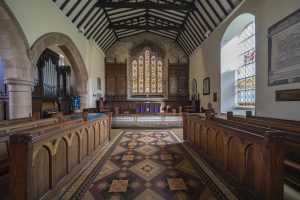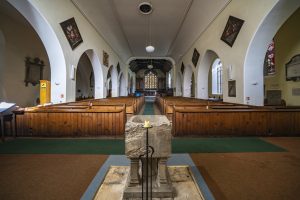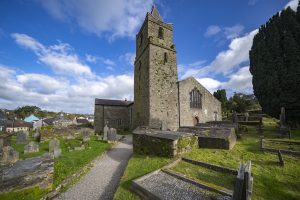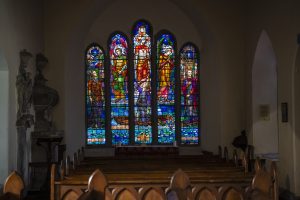Service Times
Sunday
8:30 Holy Communion
11:30 Holy Communion or Morning Prayer
5th Sunday
8:30 Holy Communion
United Service see Newsletter for details
Wednesday
12:00 Holy Communion
Overview
This historic church is one of the most important landmark buildings of Kinsale. Originally built in 1190 this church has undergone various improvements and additions throughout its 800 year history. The most dominant feature, the impressive belltower, is in fact one of the few remaining features from the original Norman church with the fourth stage and its decorations being added in 1750. Major repairs and reconstruction took place between 1835-1856 with both the floor and roof being raised at this time. The exterior contains many details from throughout its constant improvement and rebuilding phases such as stained glass and lead lined lattice work windows and various styles of window openings. The interior chronicles the history of the town with items like the flags of both William the Orange and the Highland Light Infantry who fought at Waterloo and the White Memorial Chapel that houses the burials of the Southwells who were great benefactors of the town. Also housed inside are a large amount of excellent carved timber ornamentations such as the pulpit, altar, and organ housing. As one of the most important churches in the country it has been used on multiple occasions for political ends, one of the most notable being during the English Civil War when Prince Rupert declared Charles II the new King after the execution of Charles I.
Detailed Description
Freestanding cruciform-plan Church of Ireland church with crypt, commenced c.1190, with various later additions and alterations, including upper-stage of bell tower. Renovated, remodelled and extended throughout eighteenth, nineteenth and twentieth centuries. Comprising four-stage Norman bell tower to north-west of three-bay double-height nave containing single-bay double-height chancel to east. Double-height side aisles to north and south of nave with ruinous double-height transept to south. Single-bay double-height transept and single-bay lean-to organ room with stepped basement access to north. Pitched slate roofs throughout (replaced c.1825) with steeply pitched hipped slate roof to bell tower. Concrete coping and cast-iron rainwater goods, with rendered chimneystack to transept, concrete cruciform finial to chancel, and wrought-iron weather vane surmounting bell tower. Rubble limestone walls with quoins to nave and bell tower. Carved stone gargoyles to chancel. Tooled limestone string courses and corner-sited red brick and rendered pinnacles to diminishing upper stage of bell tower with parapet having crenulated corners and metal cladding to coping. Pointed arch window openings to nave with limestone voussoirs and sills having stained glass lead lined windows. Sets of five lancet window openings having tooled chamfered limestone surrounds, mullions, and hood mouldings. Lead-lined stained glass windows to chancel, nave, and gable elevations of transepts. Tripartite and bipartite lancet windows to chancel with chamfered rendered surrounds and mullions and fixed pane timber windows. Bipartite pointed arch window openings to transept and side aisle (south) with rendered surrounds and limestone mullions having lead-lined stained glass windows. Tripartite window openings having tooled chamfered limestone block-and-start surrounds and mullions with cast-iron quarry glazed windows and lead lined stained glass windows to transept and side aisles.
Plan
If you visit the church you will see some numbered artefacts, this is a key to some of those artefacts, this will be updated shortly
- Italian marble memorial to mark the resting place of Dame Katherine, relict (widow) of Sir John Percival, baronet. She died in 1679 and was the only daughter of Robert Southwell, (see below). Note the macabre skull motif at the top of the memorial
- Memorial to mark the resting place of Robert Southwell, died 1677, and several members of his family, also in Italian marble. Erected by his eldest son, Sir Robert Southwell, one of the clerks of the The Privy Council in the reign of Charles II.
- Easter Sepulchre. Only the upper portion is now visible due to the rising of the floor level. The sepulchre is a symbolic tomb in which the altar crucifix and Reserved Sacrament would be “buried” on Good Friday” and ritually “resurrected” on Easter Sunday morning in medieval times when visual aids helped to tell the Christian story to an almost entirely illiterate congregation.
- Limestone tablet bearing a fine example of an unpunctuated Latin inscription in old English script. It records the fact that Patrick Mede, Burgess and often Sovereign of Kinsale, restored the sanctuary in 1558. He was buried at the north side of the altar in accordance with his wishes.
- Painted zinc plates erected in pitch pine arcades and dating from the 1880’s. They bear the Apostles Creed, Lord’s prayer and Ten Commandments, knowledge of which were necessary for confirmation.
- tbd
- tbd
- Tombstone of James Galwey, died 1627. The stone carries the Galwey coat of arms in its upper portion and the image of a skeletal figure surrounded by a shroud in its lower half. Below the coat of arms is to be found the beautiful motto “After dark I hope for light” inscribed in Latin, and a rhyme, also in Latin, written around the shroud in the lower half, which maybe translated as follows:
Whoe’er thou art who maybe passing here
Oh! read and pause a while, and shed a tear
I was as thou art, and thou yet shall be
What am I now: I prithee pray for me





